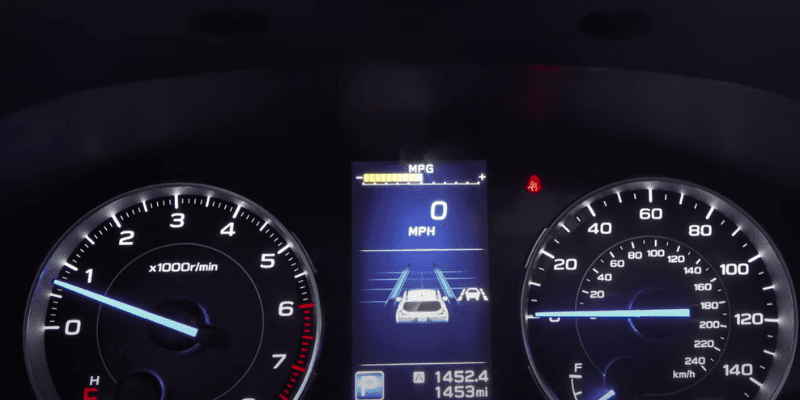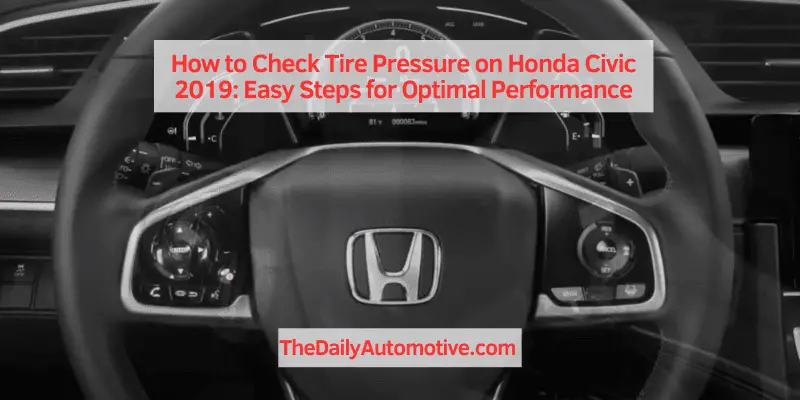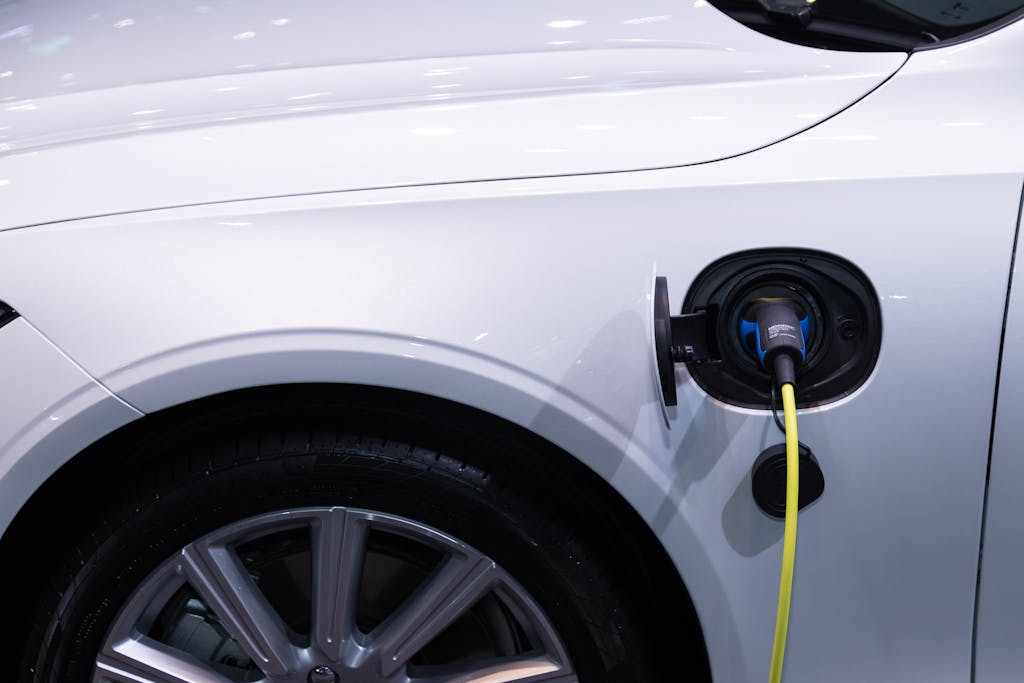How to Check Tire Pressure on Honda Civic 2019: Easy Steps for Optimal Performance
To check tire pressure on a Honda Civic 2019, locate the tire information placard inside the driver’s door or the owner’s manual, which provides the recommended tire pressure for the vehicle. To measure the tire pressure accurately, use a tire pressure gauge.
Ensuring proper tire pressure on your Honda Civic 2019 is crucial for safety and performance. By following the manufacturer’s guidelines, you can maintain optimal tire pressure, which improves fuel efficiency, extends tire life, and enhances overall driving experience. It’s important to regularly monitor and adjust tire pressure to ensure your vehicle’s safety and performance.
Continuing to drive with improper tire pressure can lead to decreased traction, uneven tire wear, and potential blowouts, compromising the safety of your vehicle and passengers. Therefore, regular tire pressure checks are essential for a smooth and safe driving experience.
Tire Pressure Importance For Honda Civic 2019
Maintaining the correct tire pressure is crucial for ensuring a smooth and safe driving experience with your Honda Civic 2019. Incorrect tire pressure not only affects the handling and safety of your vehicle but also impacts fuel efficiency and tire wear. In this article, we will explore the effects of incorrect tire pressure on your Honda Civic 2019, highlighting why it is essential to regularly check and maintain the proper tire pressure for your vehicle.
Effects Of Incorrect Tire Pressure
Incorrect tire pressure can have detrimental effects on the performance and safety of your Honda Civic 2019. When the tires are underinflated, it can lead to increased rolling resistance, causing the engine to work harder and reducing fuel efficiency. On the other hand, overinflated tires can result in reduced traction and compromised handling, especially during adverse weather conditions. It is crucial to follow the manufacturer’s recommended tire pressure guidelines to optimize the performance and safety of your vehicle.
Handling And Safety
Proper tire pressure is paramount for maintaining optimal handling and safety while driving your Honda Civic 2019. Underinflated tires can negatively impact the vehicle’s stability and responsiveness, increasing the risk of loss of control, especially during sudden maneuvers or emergency braking. Conversely, overinflated tires can lead to reduced traction and compromised braking capabilities, posing a potential hazard on the road. Ensuring the correct tire pressure is crucial for enhancing the overall handling and safety of your vehicle.
Fuel Efficiency
Maintaining the recommended tire pressure for your Honda Civic 2019 is essential for optimizing fuel efficiency. Underinflated tires can result in increased fuel consumption as the engine works harder to overcome the additional rolling resistance. On the other hand, overinflated tires can lead to reduced fuel efficiency due to decreased traction and increased tire wear. By regularly checking and adjusting the tire pressure to the manufacturer’s specifications, you can enhance the fuel efficiency of your vehicle and reduce unnecessary fuel expenses.
Tire Wear And Longevity
Incorrect tire pressure can significantly impact the wear and longevity of your tires on the Honda Civic 2019. Underinflated tires are prone to uneven wear patterns, leading to premature tire deterioration and the need for more frequent replacements. Conversely, overinflated tires can wear out the tread in the center, reducing the overall lifespan of the tires. By maintaining the proper tire pressure, you can promote uniform tread wear and extend the longevity of your tires, ultimately saving on replacement costs and ensuring a safer driving experience.

How To Measure Tire Pressure On Honda Civic 2019
When it comes to maintaining your Honda Civic 2019, one of the essential tasks is to ensure that your tires are properly inflated. Proper tire pressure not only ensures a smooth and safe ride but also contributes to fuel efficiency and longevity of your tires. In this guide, we will cover how to measure tire pressure on your Honda Civic 2019 and the tools and guidelines needed for this task.
Required Tools
Tire Pressure Gauge
The tire pressure gauge is a simple, handheld tool used to measure the air pressure in your tires. It is essential to have an accurate gauge to ensure that your tire pressure is within the recommended range.
Step-by-step Guide To Checking Tire Pressure
Are you a proud owner of a Honda Civic 2019? It’s important to keep your car’s tires properly inflated to ensure a smooth and safe drive. In this step-by-step guide, we’ll show you how to check the tire pressure on your Honda Civic 2019. Proper tire pressure not only improves fuel efficiency but also enhances the tire’s performance and lifespan. Let’s dive into the process of checking your tire pressure.
Park The Car And Prepare
- Find a level surface where you can park your Honda Civic 2019.
- Switch off the engine and engage the parking brake for safety.
- Locate the tire pressure specifications on the driver’s side door jamb or in the owner’s manual.
Correct Time And Surface
It’s best to check tire pressure when the tires are cold, as driving generates heat which increases tire pressure. Doing it on a level surface ensures accurate readings.
Safety Measures
Always put safety first when checking tire pressure. Use gloves and eye protection when necessary and keep your body clear of the car to avoid any potential hazards.
Identifying Tire Valve
The tire valve is a small cylindrical protrusion on the wheel, usually covered by the valve cap. It’s where you’ll attach the tire pressure gauge.
Location On The Wheel
The tire valve is located near the edge of the wheel, closer to the rim. Check all four wheels to identify the tire valves.
Removing Valve Cap
Unscrew the valve cap carefully. Keep it in a safe place where it won’t get lost as you’ll need to put it back after checking the tire pressure.
Using The Tire Pressure Gauge
Insert the tire pressure gauge onto the valve, ensuring a secure connection.
Proper Placement And Pressing
Hold the tire pressure gauge straight and firmly against the valve, and press the gauge down to get a reading.
Recording The Pressure
Note down the pressure reading from the gauge. Compare it with the recommended pressure stated in the owner’s manual or the driver’s side door jamb.
Repeating The Process For All Tires
- Repeat steps for each tire, ensuring you use the correct pressure specifications for the front and rear tires.
- Don’t forget to replace the valve caps securely after checking the pressure in each tire.
Importance Of Consistency
Consistently monitoring and maintaining tire pressure can improve fuel efficiency, increase tire lifespan, and ensure safe driving for your Honda Civic 2019.
Adjusting If Necessary
If any tire’s pressure is not within the recommended range, use an air compressor to add or release air until each tire reaches the specified pressure.
Maintaining Optimal Tire Pressure On Honda Civic 2019
Properly maintaining the tire pressure of your Honda Civic 2019 is crucial for ensuring a safe and efficient driving experience. Inadequate tire pressure can lead to safety risks, reduced fuel efficiency, and premature tire wear. Understanding the inflation frequency, impact of temperature and seasonal changes, typical pressure loss, effects of overinflation and underinflation, and the benefits of a tire pressure monitoring system (TPMS) can empower you to keep your Honda Civic’s tires in top condition.
Inflation Frequency
It’s essential to check and adjust the tire pressure of your Honda Civic 2019 at least once a month, ideally when the tires are cold. Insufficient pressure can lead to increased wear and reduced fuel efficiency.
Temperature And Seasonal Changes
Temperature variations affect tire pressure. As temperatures fluctuate, tire pressures can drop or rise. Check the pressure seasonally and after extreme temperature changes.
Typical Pressure Loss
On average, tires lose about 1 psi (pounds per square inch) of pressure per month due to permeation and changes in temperature.
Effects Of Overinflation And Underinflation
Overinflation can lead to increased center tread wear and a harsher ride, while underinflation can cause increased shoulder tread wear and reduced overall tread life.
Safety Risks
Incorrect tire pressure affects vehicle handling and braking, leading to increased risks of accidents and loss of control.
Tire Wear
Inadequate tire pressure causes uneven tire wear, reducing the lifespan of the tires and potentially compromising the vehicle’s performance.
Fuel Efficiency
Improper tire pressure results in increased rolling resistance, leading to decreased fuel efficiency and increased fuel consumption.
Consulting A Professional
If you’re unsure about the correct tire pressure for your Honda Civic 2019, consider consulting a professional to ensure optimal performance and safety.
Tire Pressure Monitoring System (tpms)
Make use of the TPMS in your Civic 2019, which alerts you when tire pressure is significantly low to help maintain safe driving conditions.
When To Seek Professional Help
If you notice unusual tire wear patterns, persistent low tire pressure, or your TPMS warning light is illuminated, it’s crucial to seek professional assistance to address any underlying issues.
Frequently Asked Questions For How To Check Tire Pressure On Honda Civic 2019
How Often Should I Check The Tire Pressure On My Honda Civic 2019?
Regularly check your tire pressure at least once a month and before long trips. Properly inflated tires ensure better fuel efficiency and safe driving.
What Is The Recommended Tire Pressure For Honda Civic 2019?
Refer to the owner’s manual or the sticker inside the driver’s side door jamb for the recommended tire pressure. It’s important to maintain the correct tire pressure for optimal performance and safety.
Can I Check The Tire Pressure At Home Without A Tire Pressure Gauge?
You can use a digital or manual tire pressure gauge to check the tire pressure at home. They are affordable and easy to use, enabling you to maintain your tire pressure regularly.
Conclusion
To sum up, regular tire pressure checks are essential for ensuring safety and optimal vehicle performance. By following the steps outlined in this guide, you can easily maintain the correct tire pressure on your Honda Civic 2019. Remember, proper tire pressure leads to better fuel efficiency and extends the lifespan of your tires.
Stay safe on the road!









2 Comments